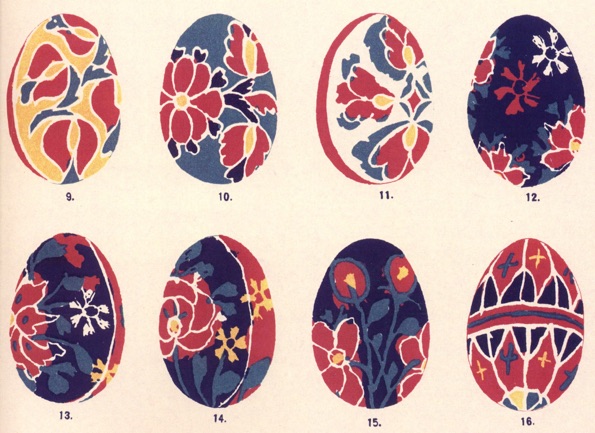Flower Motifs
“Kvitka”

Flower Motifs
“Kvitka”
Flower symbols are frequently found on pysanky, and fall into three general categories: vazony (flowers in a flowerpot), ruzhi (or rozhi, eight petal flowers), and other flowers. The first are a berehynia symbol; the second, sun symbols; the last group are discussed here.
Traditional pysanky abound with flowers. As Selivachov noted, “it is natural that the favorite motif of the Ukrainian peasant should be the flower. It is the plant’s smile, a sign of its essence, the peak of the annual cycle from seed to fruit, which will provide new seed. For the peasant, flowering is the most crucial time, for this is when he fruit is fertilized or the barren flower wilts......In folk art the flower is one of the most meaningful symbols. Artist give flower-lie appearances to people, birds, animals. This flows organically from the folk mentality. Recall the folkloric comparison of a girl with a flower, a small bird or a fish.....or the poet Shevchenko’s expressions: “my thoughts–my flowers,” “my bird–my flowering poppy,” “my brother–my royal bloom.”
Flowers are a symbol of beauty and of fertility and abundance.
The “other flowers” found on pysanky can also be subdivided. First there are the very widespread “kvitka” (flower) motifs. These are defined by their non-definition--there are no specific botanical features, it is a generic flower, not a specific one.
The second group is specific named flowers. In this group we see flowers which usually bear at least a passing resemblance to their botanical namesakes: carnations, bells, daisies, violets, sunflowers and others.
The third category is“exotic” flowers. These are usually given the names “tulipany” or “telepany” (tulips) or “orkhidea” (orchid). It was not so long ago that these plants were quite foreign to Ukraine, and few had ever seen them. These were fantastical names given to fantastical flowers, and the symbols usually bear no resemblance whatsoever to the named plants.
Lastly there are the Sokal florals. In the late 19th century two trends pushed changes in the pysanky of Sokal: a trend towards naturalism, along with the popularity of china painting. These two trends resulted in a specific floral style, sometimes isomorphic, and other times quite fantastical.
KVITKY: Selivachov has provided us with a great number of “”kvitka” motifs found on pysanky:

PYSANKA MOTIFS
1) Kyiv
2)Zhytomyr
3)Chernihiv
4)Chernihiv
5)Elizavethrad
6)Vinnytsia
7)Vinnytsia
8)Hutsul
9) Poltava
11)Poltava
12)Poltava
13)Poltava
16)Vinnytsia
17)Vinnytsia
As you can see, flower motifs vary in size and shape, but have the common feature of a lack of specific features. They resemble a child’s conception of of a flower–petals, from a common center, often with a central disk, in various arrangements. It is the multiple petals which make a motif a flower.
On the other hand, motifs like these–a central ovoid with a serrated outline–are much more likely to be leaves, and are often identified as oak leaves. More complex such designs, like the lower example below, can be seen on Sokal pysanky, where they may be leaves, flowers or buds.

Below are a few examples of “kvitky” on pysanky from Binyashevsky, with examples from the Chernihiv, Kharkiv and Lemko regions:



These are examples of a variety of kvitka motifs on pysanky I have written; these first three are from Vinnytsia, Zakarpattia and Cherkasy regions:



These floral pysanky are from Hrubeshiv, Kuban and the Kirovohrad region:



These are from Podillia, Kyiv (2):



.
These are from Odesa.

Spring blossoms
Back to Phytomorphic Gallery page.
Back to MAIN Symbolism home page.
Back to MAIN Pysanka home page.
Back to Pysanka Index.
Search my site with Google
